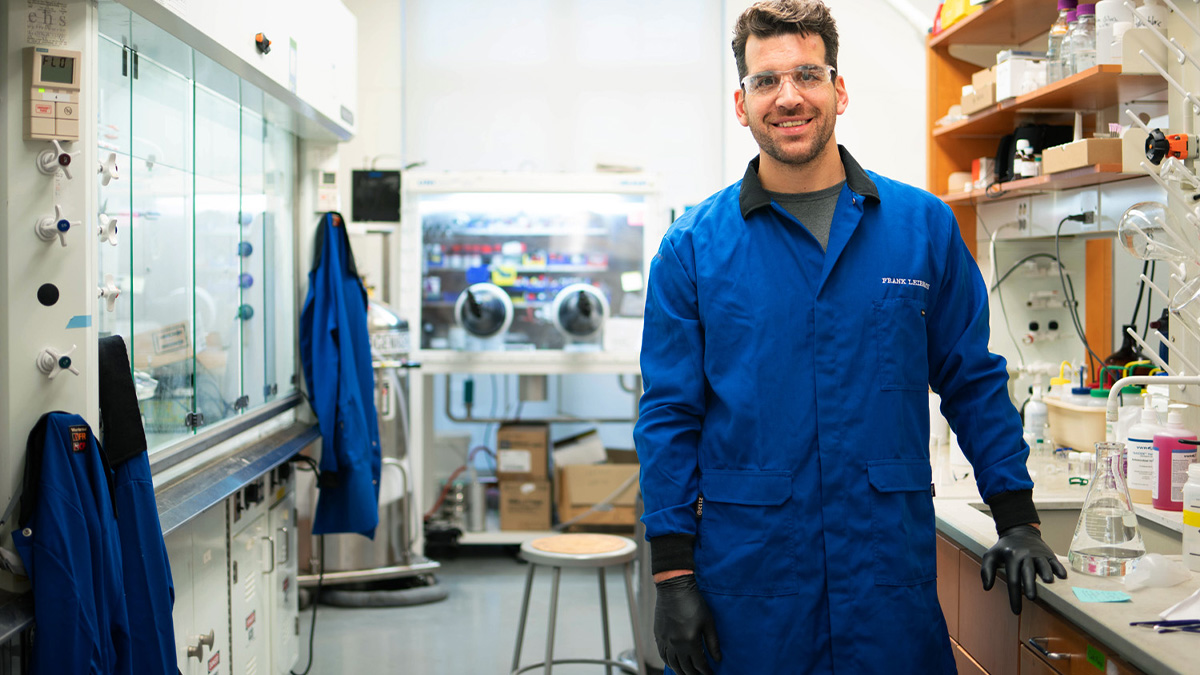April 17, 2023 | By John Gove, Endeavors
On Sundays from September to February each year, upwards of 70,000 fans flock to Bank of America Stadium in Charlotte to cheer on the Panthers. The stadium fills with noise, energy and people, but most of the space is empty, only occupied by the usually crisp fall and winter air.
Every day, U.S. manufacturers make enough plastic products to fill the Panthers’ stadium — from turf to the brim, from end zone to end zone and from the sidelines to the nosebleeds.
Plastics make products lighter and more effective, but their disposal is problematic. Of each stadium’s worth of plastics, the U.S. only recycles 8.7%. The rest ends up in landfills, in incinerators or as environmental pollutants after they outlive their useful lives.
“By 2050 scientists predict there will be more plastic in the ocean than fish,” said Frank Leibfarth, an associate professor in the chemistry department at Carolina.
Instead of using traditional approaches like mechanical recycling to mitigate the plastic waste issue, Leibfarth focuses on polymers — collections of large molecules that are the building blocks of many of the world’s natural and synthetic materials.
Silk, wool and DNA are examples of naturally occurring polymers, while nylon, epoxy and polyester are synthetic. Leibfarth and his team study the most-used plastics in society, called polyolefins, to find ways to change their chemistry and make them more valuable.
Polyolefins encompass two categories of plastics, polyethylene and polypropylene, and make up 65% of all the plastics used in the world. Plastic bags and milk jugs are made of polyethylene. Polypropylene can be found in the exterior of cars.
A similarity shared by all polyolefins is the simplicity of their chemistry. They are made completely of carbon and hydrogen, with two of the strongest types of bonds known to chemists.
“The chemistry is what makes recycling polyolefins particularly challenging, but chemists get really excited about it,” Leibfarth said.
Solutions to the plastic waste problem have been on the agenda of chemistry researchers for decades.
“This is exactly what we can try to solve at UNC with interdisciplinary collaboration and some creativity.”
Adding value
To solve this challenge, Leibfarth and his team develop reagents — molecules that react with a bond in the polymers that make up a plastic product — and transform polyolefins into materials with different properties and uses.
Reagents are like the cream of tartar that stiffens egg whites into a fluffy meringue.
Reagents could be sprinkled into plastic waste in current recycling infrastructure — which relies on mechanical processes to wash, chop and grind the waste — to react within processing machinery and result in a new material.
Sounds simple, right?
Not exactly. Leibfarth and his team do not know which molecules will make successful reagents. Discovering these is like doing math problems when learning algebra. You plug numbers into an equation to see if they solve for the missing variable.
These reagents are also very specific to certain types of plastics. Currently, applying them into established infrastructure requires a homogeneous waste stream with only the type of plastic that they can react with. The mixed recycling streams that are used locally are too complex for the known reagents, so far, and the waste is often too dirty and filled with contaminants.

“The chemistry works, though,” Leibfarth said. “We have been successful with virgin polyethylene and with clean postconsumer waste.”
Recycling the cleanest waste streams, which still have levels of contamination, shows the potential of his research being impactful outside of the lab.
Some companies already turn plastic waste into new products. Lawn furniture is sometimes made from milk jugs, but it is less valuable by weight as a chair than as a bottle. This is called downcycling — turning waste into a product that is less valuable and what we often think of as recycling.
“We want to make the plastics more useful, more functional and give them better properties,” Leibfarth said.
So, he and his team are searching for reagents to facilitate the upcycling of common waste streams.
Upcycling turns waste into something more valuable. Leibfarth has found a reagent that can chemically alter the polymers of a milk jug to become a plastic similar to Surlyn — the clear, strong and pliable plastic found in heat-sealed packages, high-end yoga mats and inside of golf balls. By weight, this product is much more valuable.
Chemistry collaborations
Reagents are not a new concept. Across the globe, scientists are using them to solve the plastic waste problem, but chemists at Carolina have made reagents that are more selective than previously thought possible by working across disciplinary boundaries.
Leibfarth began this project with Erik Alexanian, a colleague and chemistry professor. Instead of focusing on plastics, though, much of Alexanian’s work is in medicinal chemistry. Using the same foundational concepts, he can improve the efficacy of pharmaceuticals.
Both directions of research focus on the hard-to-break carbon-hydrogen bonds. Medicinally, Carolina researchers have found ways to work with previously inaccessible C-H bonds. In the recycling world, they have discovered reagents that facilitate the upcycling of plastic waste.
To solve the latter, Leibfarth and his team will need continued collaboration throughout the plastics value chain. Upcycling is one cog in the wheel of recycling, spinning in conjunction with mechanical recycling, repurposing and breaking down waste into energy sources.
“The goal is to keep the carbon from plastic in the economy for as long as possible,” Leibfarth said. “But there is no one silver bullet solution to this problem.”


